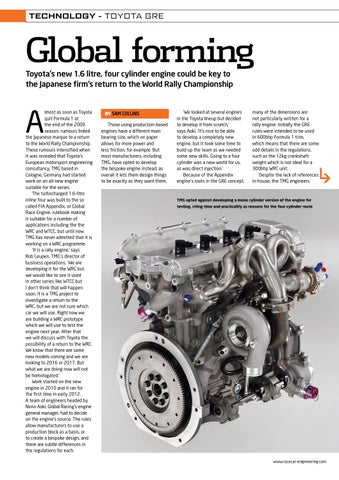TECHNOLOGY - TOYOTA GRE
Global forming Toyota's new 1.6 litre, four cylinder engine could be key to the Japanese firm's return to the World Rally Championship
A
lmost as soon as Toyota quit Formula 1 at the end of the 2009 season, rumours linked the Japanese marque to a return to the World Rally Championship. These rumours intensified when it was revealed that Toyota's European motorsport engineering consultancy, TMG based in Cologne, Germany had started work on an all-new engine suitable for the series. The turbocharged 1.6-litre inline four was built to the so called FIA Appendix, or Global Race Engine, rulebook making it suitable for a number of applications including the the WRC and WTCC, but until now TMG has never admitted that it is working on a WRC programme. 'It is a rally engine,' says Rob Leupen, TMG's director of business operations. 'We are developing it for the WRC but we would like to see it used in other series like WTCC but I don't think that will happen soon. It is a TMG project to investigate a return to the WRC, but we are not sure which car we will use. Right now we are building a WRC prototype which we will use to test the engine next year. After that we will discuss with Toyota the possibility of a return to the WRC. We know that there are some new models coming and we are looking to 2016 or 2017. But what we are doing now will not be homologated.' Work started on the new engine in 2010 and it ran for the first time in early 2012. A team of engineers headed by Norio Aoki, Global Racing's engine general manager, had to decide on the engine's source. The rules allow manufacturers to use a production block as a basis, or to create a bespoke design, and there are subtle differences in the regulations for each.
by SAM COLLINS Those using production-based engines have a different main bearing size, which on paper allows for more power and less friction, for example. But most manufacturers, including TMG, have opted to develop the bespoke engine instead, as overall it lets them design things to be exactly as they want them.
'We looked at several engines in the Toyota lineup but decided to develop it from scratch,' says Aoki. 'It's nice to be able to develop a completely new engine, but it took some time to build up the team as we needed some new skills. Going to a four cylinder was a new world for us, as was direct injection.' Because of the Appendix engine’s roots in the GRE concept,
many of the dimensions are not particularly written for a rally engine. Initially the GRE rules were intended to be used in 600bhp Formula 1 trim, which means that there are some odd details in the regulations, such as the 12kg crankshaft weight which is not ideal for a 300bhp WRC unit. Despite the lack of references in-house, the TMG engineers
TMG opted against developing a mono cylinder version of the engine for testing, citing time and practicality as reasons for the four-cylinder route
www.racecar-engineering.com
